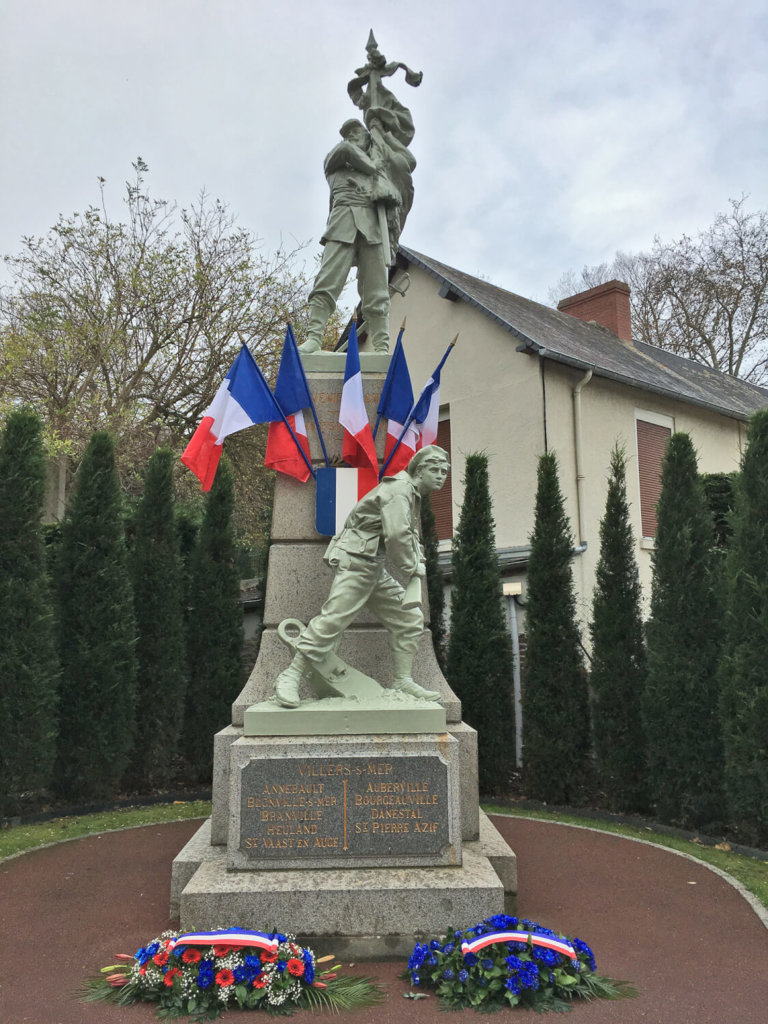Outdoors in World War I country
 The French know how to honor their dead, and they have many to mourn. In 1914, France had a population of 40 million. By the end of the Great War, the war to end all wars, one in 20 French citizens was dead. In the first year of the war, 1914, every day on average 2,200 Frenchmen died. It’s hard to get your head around these numbers. In two days, the entire population of Charlotte would be gone.
The French know how to honor their dead, and they have many to mourn. In 1914, France had a population of 40 million. By the end of the Great War, the war to end all wars, one in 20 French citizens was dead. In the first year of the war, 1914, every day on average 2,200 Frenchmen died. It’s hard to get your head around these numbers. In two days, the entire population of Charlotte would be gone.
The First World War was the first modern war. Tanks, chlorine and mustard gas, airplanes, machine guns and automobiles were among man’s inventions that altered the character of war and exploded the casualties. Animals also participated. Horses pulled ambulances, towed mortars, and slogged along muddy roads, mired in traffic among Renault tanks and narrow-tired Model T ambulances. By 1918, 400,000 horses had succumbed.
Even as telephones and wireless were utilized for the first time, carrier pigeons transported messages; an estimated 300,000 were employed throughout the course of the war. Some were even tricked out with aerial reconnaissance gear. A December 1914 order, in French, from the German kommandantur, mandates that all carrier and domestic pigeons be destroyed under penalty of the most severe punishments.
Dogs were also used as couriers, carrying encoded messages faithfully and speedily.
At the Museum of the Great War, in Meaux, France, an order of requisition hangs: all horses having attained the age of five years by January 1, 1914—as long as their shoes were in a good state—and all mules having attained the age of three were requisitioned by the French state. The mayor of each town would appear at a designated time and place to accept the animals in the name of the French Republic.
Posters admonished the French not to waste bread and to eat potatoes instead. Others inspired: Cultivate Your Vegetable Garden; Eat More Fish and Less Meat; To Not Waste Bread is our Duty; Break your sugar (cube) in two in order to have some tomorrow. A photo of a hen on a mountain of eggs proclaims, “I eat little but produce a lot.” A poignant drawing of three small children gazing up at the window of a pastry shop stacked with sweets; the caption: We will learn how to deprive ourselves.
In recent weeks, as leaders of 70 nations traveled to Paris to commemorate the end of World War I and honor those who died, my family traveled to the Western Front in France, retracing my grandfather’s route in the Engineer Corps in 1917-18.
One hundred years later, sometimes to the day, we traveled across ground that the American Expeditionary Force, fighting with French soldiers, reclaimed from the occupying Germans. Fighting from trenches dug into the muddy earth, French and German troops had been at a stalemate for more than three years. When the AEF entered the war in 1917 with fresh if untrained and untested troops, they changed the course of the war.
Imagine, if you can, cold, muddy and wet trenches infested with lice and rats. Add hunger to the mix. Then, consider mortars, grenades and chlorine and mustard gases.
Our detailed Michelin road atlas is peppered with tiny crosses: German cemetery, French cemetery, American cemetery. Surprisingly we found several French cemeteries adjoining German ones.
We wandered the trenches at Douaumont and Dead Man’s Hill. We walked in the Red Zone, 460 square miles of land so disturbed, compressed, riddled with unexploded ordinance and permeated by chlorine and mustard gas that it would never be tilled or inhabited again. Forests of beech grow where nothing else will.
At Meuse-Argonne Cemetery, the largest of America’s World War I memorials in Europe, 14,246 graves, including 22 sets of brothers, stretch to the horizon. Among them, 486 are unknown; 954 names are listed on the Walls of the Missing that surround a somber chapel overlooking the sea of white crosses and stars of David. In addition to the casualties of war, more than 40,000 men serving in the military in World War I lost their lives to the greatest pandemic of the 20th century, the Spanish flu. The flu was the main cause of death of women who supported the troops as nurses, ambulance drivers and telephone operators.
Interesting in this moment of disagreement on immigration, General Pershing’s Army reflected the demographics of America at the time; 18 percent of service members were foreign born, including my Danish-born grandfather.
On Nov. 11, at 11 a.m., in every village, town and city in France, church bells rang for five minutes as they had one hundred years before. We gathered with friends, in the drizzle, around the war memorial in their town. Rain dampened our clothes but not our spirits.

